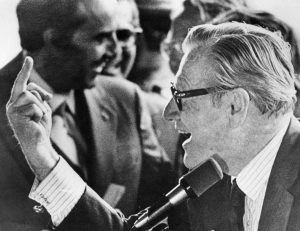In reading the chapters this week from Austerity Blues, I couldn’t help but see the history of the SUNY/CUNY struggle through the haunting glow of Nelson Rockefeller’s ego.

Figure 1: Nelson Rockefeller showing his respect for SUNY students, 1976.
To share some personal bias, I am completely spellbound by the vile and repugnant history of the Rockefeller dynasty. It is truly a family history I love to hate. They are completely entwined with many horrors of history– chiefly the support and maintenance of American white supremacy.
With the exception of his scandalous death, Nelson’s legacy remains largely untarnished in the neo-liberal telling of history. As the namesake of “Rockefeller republican”, he is sometimes retroactively praised for his expansions of public goods and work against discrimination. He may have been the most progressive Rockefeller, even on issues of race, but that is a bar you couldn’t lower without a shovel. The Rockefeller name is one synonymous with eugenics and white supremacy, with the family’s foundation fiscally supporting both the Eugenics Records Office in New York as well as Nazi racial studies abroad for most of the 1930s. While Nelson was beginning his career at that time, he was still a seminal figure in implementing mechanisms of institutional oppression and entrenching racial divides we still see today.

Toilet-shaped Performing Arts centre, Empire Plaza (Albany)
Here are the only things you need to know about Nelson: He built the Empire Plaza in Albany in order to displace a growing black neighbourhood; he violently suppressed (dominantly) Black and Puerto Rican inmates during the Attica prison rebellion; and most devastatingly, he was responsible for the NYS ‘Rockefeller drug laws’ which targeted young minorities so effectively that it became the model for the nationwide War on Drugs.
With this history in mind his “crowning achievement” of the SUNY system, and adversarial relationship with CUNY, is quite revealing. The history discussed in the text—from the G.I. bill to CUNY’s implementation of tuition–can be read as struggle to defend white prosperity. At every turn CUNY’s free tuition was a deal-breaker for Nelson, while the state comfortably subsidized private institutions. It is also worth pointing out he rebuffed CUNY both as governor and as Vice President in the Ford administration, which rejected the city/state appeal for funding specifically because of free tuition. Even within SUNY this insistence on tuition seems to come from a place other than simple frugality or moralization. Tuition simply seemed to be the most effective tool to keep the ‘public good’ private, and the SUNY subsumption of CUNY was his bigger, better, Empire-Plaza-in-the-sky.
While some solutions come quickly to us (free tuition, open admissions, etc), every victory in the public sector comes with the looming threat of austerity. Once beneficiaries of a public can be more diverse, they will be more diverse, making them easier to villainize. How can we defend any public good if their existence is contingent upon pleasing the rich and/or currying favour with racists? Are we stuck holding hands with Nelson Rockefeller every step of the way?
Any hope we may find in this dire situation, I am convinced, will be rooted in a civics divorced from statecraft. That is, if teachers want to teach, and students want to learn, how do we identify and destroy the barriers between them to make a grass-root university? While I do dream at night about an open-sourced-decentralized-education platform which eschews both public austerity and private profit motives…do such visions really address these systemic problems? Where does “access” end and “digital colonialism” begin?




сколько стоит капельница на дому от запоя сколько стоит капельница на дому от запоя .
сделать капельницу на дому от алкоголя сделать капельницу на дому от алкоголя .
SportyBet SportyBet .